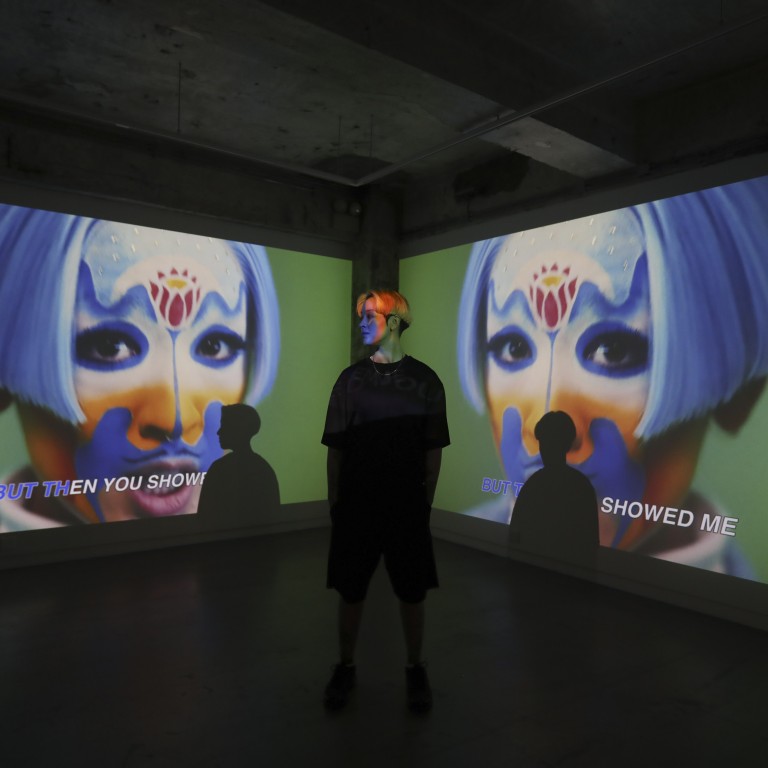
How BTS and Mirror help Hong Kong artist represent nonbinary genders and fluidity of existence
- Boy bands including the K-pop and Canto-pop giants form the central idea behind Sin Wai-kin’s new Hong Kong exhibition ‘It’s Always You’
- The non-binary artist plays four different male roles in a fictional boy band, complete with music videos and life-size cut-outs
Halfway through our interview, Sin Wai-kin says they might have played Victoria Sin for the last time in summer 2020.
Given that Victoria Sin happens to be the English name of the non-binary artist, who prefers to be referred to by the pronouns “they” and “their”, the statement suggests a deeper transformation and is not merely an actor’s declaration of putting their most beloved role to bed.
For someone who performs in drag within speculative fictional worlds, “Victoria Sin” and “Sin Wai-kin” (Sin’s Chinese birth name, which is not particularly male or female) have also been the artist’s main characters embodying different gender and cultural ideals.
The 30-year-old, who describes themselves as being assigned female at birth, performed for years as Victoria Sin, a voluptuous, heavily made-up platinum blonde vixen inspired by Marilyn Monroe and Jessica Rabbit. The artist, born in Toronto to a Chinese father and Caucasian English mother, adopted the camp femininity of drag queens and painted faces reminiscent of Chinese opera characters as a way to question the socially constructed nature of gender, and the fluidity of identity.

But for the opening of “It’s Always You”, a solo exhibition at Hong Kong’s Blindspot Gallery, Sin is sticking to being Sin Wai-kin.
It’s Always You is also a boy band “formed” by Sin playing four different male roles. At Blindspot, you will see their music videos and life-size cut-outs.
‘I think my labia is ugly’: removing negativity from ‘down there’
The idea of using drag to explore Sin’s more masculine side came up during the pandemic, which gave the artist time and space to think more about their art practice.
“Since slipping out of Victoria, I realised that [the possibilities are] infinite,” Sin says. “If drag is a process of undoing the binary of what is and what isn’t me, and through that, working out various desires, then there is no end to it. My work has been about undoing colonial ideas within femininity. I kind of turned round and realised there was this whole unexplored world. What is masculinity?”

Sin appeared as “The Storyteller” at the opening, the “serious one” of the fictional boy band who sometimes appears as a newsreader – to drive home the point about representation versus truth – and whose expressions and gestures invoke Aaron Kwok Fu-shing, one of the “Four Heavenly Kings” of Canto-pop in the 1990s.
Sin watched old Hong Kong movies for inspiration on how the band members should act. For example, “The Universe”, who is more flamboyant than “The Storyteller”, is inspired by Hong Kong movie stars Tony Leung Chiu-wai and Leslie Cheung Kwok-wing.
But it is boy bands in general, from N’Sync to BTS and Mirror, that form the central idea behind “It’s Always You”.
The fact that we are always in the process of transformation is alarming, but it’s also really liberating
“‘Together we reflect unlimited possibilities,’” Sin quotes from the band’s Instagram. “Their IG profile description is just so perfect.”
At the same time, boy bands are perfect vehicles for thinking about how we all fit into the rest of the community, Sin adds. “In a boy band, individuals come together to form a whole, which is more than the sum of its parts.”

The exhibition includes dual-screen displays that show the four characters as a group as well as close-ups of each one. These images seem to ask: can “you” as a person exist in a boy band where the individual’s every move is choreographed so it fits within the group?
Sin’s transition from female to male characters is not just about shattering the binary of genders, but a symbol of the fluidity of all existence in Taoist philosophy, something the artist expands on in a work called A Dream of Wholeness in Parts (2021) which invokes Chuang Tzu’s famous “Butterfly Dream” that questions perception and reality.
The constant shifting between characters leaves one wondering where the “real” Sin is. In person, the artist is soft-spoken and gives considered answers after taking the time to consider each question. But is “The Artist Being Interviewed” just another role?
“The fact that we are always in the process of transformation is alarming, but it’s also really liberating,” Sin says. “Drawing a line around yourself and saying ‘this is where I feel comfortable’ – most people do that. But I find every time I step out of that line, I’m also redefining that line. And it is still me. Always me.”

Each version of Sin is also a representation of our collective fantasy, hence the title of the exhibition. And a series of works that are imprints of Sin’s make-up on face wipes after drag performances attest to the many identities the artist has embodied.
“I mean, Jessica Rabbit was created by a group of men, who channelled all their desires through this sultry, ultra-feminine character. It’s very interesting … her gestures, movements, her looks, when what happens in fantasy isn’t grounded in a physical body.”
For now, however, Sin might have enough characters to explore. Who is Sin behind the make-up and the drag? Perhaps they are the carrier of a myriad of selves.
“It’s Always You”, Blindspot Gallery, 5/F, Po Chai Industrial Building, 28 Wong Chuk Hang Road, Wong Chuk Hang, Tue-Sat, 10.30am-6.30pm. Until Jan 8, 2022.
